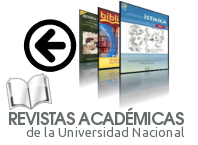EVALUACIÓN DE HÁBITAT POTENCIAL PARA LA DANTA CENTROAMERICANA (TAPIRUS BAIRDII) EN EL CORREDOR BIOLÓGICO SAN JUAN-LA SELVA, COSTA RICA
Resumen
La danta centroamericana (Tapirus bairdii) es el mamífero terrestre de mayor tamaño en el Neotrópico. Es un importante dispersor de semillas que contribuye al enriquecimiento de especies en los bosques donde habita. Varios estudios ecológicos han permitido conocer esta especie discreta; sin embargo, su distribución y el tamaño de sus poblaciones permanece sensiblemente desconocido fuera de las áreas silvestres protegidas. El propósito de esta investigación consistió en proponer una metodología de análisis geo-espacial sencilla que permitiera realizar una evaluación rápida del hábitat potencial para la danta centroamericana. Se seleccionaron siete variables de la ecología de la danta centroamericana, las cuales fueron evaluadas en el Corredor Biológico San Juan-La Selva, mediante un sistema de información geográfica (SIG). Estimamos la población de dantas con un rango de 69 a 208 individuos. Esto es una manera barata de determinar la viabilidad del hábitat de la danta cuando existe información confiable sobre los procesos dinámicos de los ecosistemas presentes en el área del estudio.
Palabras clave: Tapiridae, danta centroamericana, Tapirus bairdii, evaluación de hábitat, analisis geo-espacial, Corredor Biológico San Juan-La Selva, Costa Rica
Abstract:
Baird’s Tapir (Tapirus bairdii) is the largest terrestrial mammal in the Neotropics. It is an important seed disperser that contributes to the enrichment of species in the forests where it lives. Several ecological studies on this species have generated knowledge about this discreet species; nevertheless, its distribution and the size of its populations outside protected wildlife areas sensibly remain unknown. The purpose of this investigation consisted in proposing a simple methodology of geo-space analysis that allowed realizing a fast evaluation of the potential habitat for Baird’s Tapir. Seven variables of the ecology of Baird’s Tapir were selected, which were evaluated in the San Juan-La Selva Biological Corridor, using a geographical information system (GIS) program. We estimated the tapir population to range from 69 to 208 individuals. This is an inexpensive way to assess Tapir’s habitat viability when there is a strong knowledge about the dynamic processes from the ecosystems present in the study area.
Key Words: Tapiridae, Baird’s Tapir, Tapirus bairdii, habitat viability assessment, geo-spatial analysis, San Juan-La Selva Biological Corridor, Costa Rica
Descargas
Publicado
Cómo citar
Número
Sección
Licencia
Política propuesta para Revistas que ofrecen Acceso Abierto
Los autores que publican en esta revista están de acuerdo con los siguientes términos:
a. Los autores conservan los derechos de autor y garantizan a la revista el derecho de ser la primera publicación del trabajo, bajo la Licencia https://creativecommons.org/licenses/by-nc-sa/4.0/deed.es, que permite a otros compartir con un reconocimiento de la autoría del trabajo y la publicación inicial en esta revista.
b. Los autores pueden establecer por separado acuerdos adicionales para la distribución no exclusiva de la versión de la obra publicada en la revista (por ejemplo, situarlo en un repositorio institucional o publicarlo en un libro), con un reconocimiento de su publicación inicial en esta revista. Esos acuerdos adicionales deben respetar los términos de la licencia: es decir: no involucrar fines de lucro y compartir con la misma licencia.
c. Se anima a los autores a archivar el post-print o versión de editor/PDF en repositorios de acceso abierto.







 REVGEO se encuentra bajo la licencia https://creativecommons.org/licenses/by-nc-sa/4.0/deed.es
REVGEO se encuentra bajo la licencia https://creativecommons.org/licenses/by-nc-sa/4.0/deed.es
.svg_4.png)

_(1).png)
_(1)_(1)_(1)_1.png)
(2)(1)(1)(1).png)
